Best Night Sky Events of January 2014: Stargazing Sky Maps (Gallery)
New Moon, January 2014
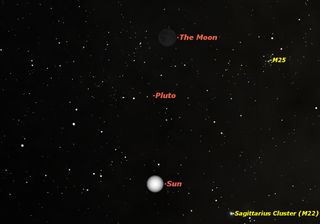
Wednesday, Jan. 1, 6:14 a.m. EST. The Moon is not visible on the date of New Moon because it is too close to the Sun, but can be seen low in the east as a narrow crescent a morning or two before, just before sunrise. It is visible low in the west an evening or two after New Moon. This is the first of two New Moons this month.
First Quarter Moon, January 2014
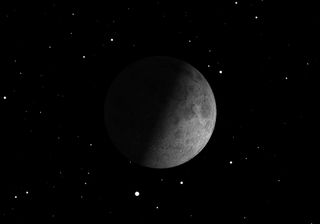
Tuesday, Jan. 7, 10:39 p.m. EST. The First Quarter Moon rises around 11:20 a.m. and sets around 12:50 a.m. It dominates the evening sky.
Full Moon, January 2014
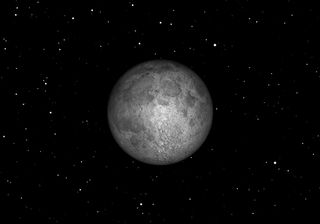
Wednesday, Jan. 15, 11:52 p.m. EST. The Full Moon of January is known as the Wolf Moon or the Old Moon. It rises around sunset and sets around sunrise, the only night in the month when the Moon is in the sky all night long. The rest of the month, the Moon spends at least some time in the daytime sky. This will be the smallest full moon in 2014.
Last Quarter Moon, January 2014
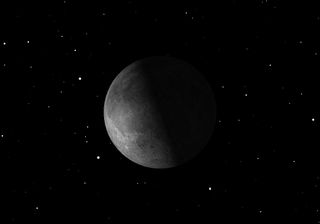
Friday, Jan. 24, 12:19 a.m. EST. The Last Quarter Moon rises around 1 a.m. and sets around 11:40 a.m. It is most easily seen just after sunrise in the southern sky.
New Moon, January 2014
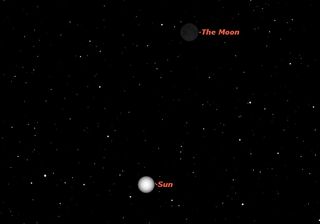
Thursday, Jan. 30, 4:38 p.m. EST. This is the second New Moon this month. There is no special name for this event.
Venus and Moon Together: Jan. 2, 2014
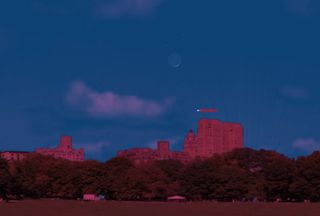
This sky map shows the location of Venus and the moon in the southwestern sky just after sunset on Jan. 2, 2014 as seen from mid-northern latitudes. [Read the Full Story Here]
Quadrantid Meteor Shower, January 2014
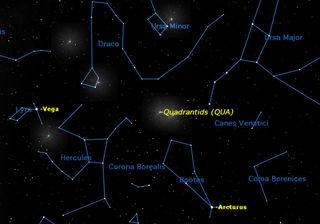
Thursday and Friday, Jan. 2 and 3, between midnight and dawn. The Quadrantid meteor shower peaks at 3 p.m. EST on January 2, during daylight. The best times to observe will be Thursday morning and Friday morning, between midnight and dawn. The meteors appear to radiate from a point between northern Bootes and the handle of the Big Dipper, once part of an obsolete constellation called Quadrans Muralis, the Wall Quadrant.
Get the Space.com Newsletter
Breaking space news, the latest updates on rocket launches, skywatching events and more!
Jupiter at Opposition, January 2014
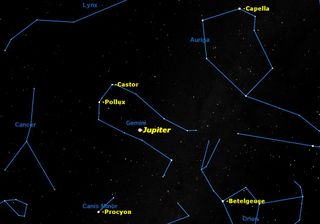
Sunday, Jan. 5. Jupiter will be exactly opposite the Sun in Earth’s sky. It rises in the east at sunset and sets in the west at sunrise, visible all night long. Jupiter is currently in the far northern constellation of Gemini, so will be high in the sky for northern observers, surrounded by five of the brightest stars in the sky: Capella, Betelgeuse, Procyon, Pollux and Castor.
Venus at Inferior Conjunction, January 2014
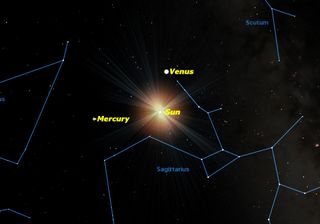
Saturday, Jan. 11. In its transition from “evening star” to “morning star,” Venus passes between Earth and Sun today. Because of the tilt of its orbit, it passes six degrees north of the Sun, rather than directly in front as it did in June 2012.
The Moon Close to Spica, January 2014
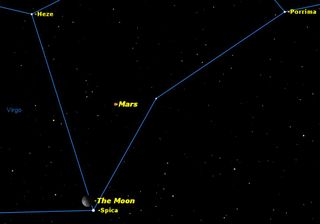
Thursday, Jan. 23, 5 a.m. EST. The Moon will pass just north of the bright star Spica in Virgo, with Mars close by.
The Moon Close to Saturn, January 2014
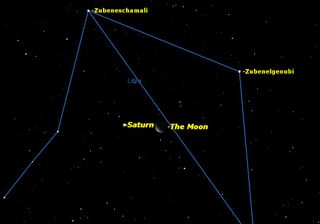
Saturday, Jan. 25, Early Morning. The Moon will pass just south of Saturn in Libra. The Moon will occult Saturn for observers in French Polynesia, New Zealand, southern South America, and Antarctica.
Join our Space Forums to keep talking space on the latest missions, night sky and more! And if you have a news tip, correction or comment, let us know at: community@space.com.

Space.com is the premier source of space exploration, innovation and astronomy news, chronicling (and celebrating) humanity's ongoing expansion across the final frontier. Originally founded in 1999, Space.com is, and always has been, the passion of writers and editors who are space fans and also trained journalists. Our current news team consists of Editor-in-Chief Tariq Malik; Editor Hanneke Weitering, Senior Space Writer Mike Wall; Senior Writer Meghan Bartels; Senior Writer Chelsea Gohd, Senior Writer Tereza Pultarova and Staff Writer Alexander Cox, focusing on e-commerce. Senior Producer Steve Spaleta oversees our space videos, with Diana Whitcroft as our Social Media Editor.